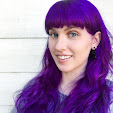Recently I've taken to listening to the
Crafty Planner podcast by Sandy Hazlewood during my sewing sessions. As I've been devouring both new and past episodes, I've noticed a theme during Sandy's interviews with various sew-lebrites: the idea of being an "artist."
In episode 35 with Mandy Lein, Mandy tenuously calls herself an artist, as if she is unsure if she's earned the title. While I have nothing but respect for Mandy and I would never challenge the way someone chooses to identify themselves, I was struck by my aversion to identify myself as an artist.
This isn't a new revelation for me. I've never felt quite right calling myself an artist. Even as an art major in college, I felt that the title was still missing the mark. Hearing people talk about being artists within the quilting industry stirred up my bottled up university art department experiences. I think that some people call themselves "artists" in order to elevate their work. A person who makes quilts might introduce themselves as an artist rather than a quilter because they feel that the former title has more distinction.
The problem I have with this rationale is that it implies that being a quilter is not good enough.
It's no secret that pursuits like quilting, knitting, scrap booking, etc. are deemed "crafts" or "hobbies," while the mediums that have historically been dominated by men (painting, photography, sculpture, etc.) are the ones we call "art." On the Crafty Planner podcast, Lizzy House (episode 35) even comments that when a woman makes a quilt, it's a quilt. When a man makes a quilt, it's art.
This is where my college art major angst kicks in. Most of my professors and peers were firmly in the fine art scene, with many being
conceptual artists. As a representational artist, I frequently found myself at odds with others. I was unintentionally trained to bullshit a conceptual thesis to bolster my illustrations, for without one my work was deemed to be shallow, empty, or vapid. In their minds, a piece is good when it sparks a 30 minute discussion or debate. To me, art should leave you speechless. I feel that when ideas are more important than aesthetics, it should be called "visual philosophy" or something like that because the medium is nothing but an incidental vehicle to express the thought. One of my professors began referring to my work as "illustration," (a term I have zero issue with) like it was a dirty word. In college, some dismissed my work as illustration, and now some dismiss my quilts as "craft."
During my senior year of college, I vowed not to let illustration be a dirty word. I began introducing myself as an illustrator. These days, I wear a lot of hats. Quilter, pattern designer, fabric designer, blogger, etc. At the core of it all, I am a maker. There is no definitive answer for what makes something craft or art, but either way, they both involve the act of making. Making things is what brings me joy, and the word "artist" always makes me think of judgement and elitism. I am not an artist.






































